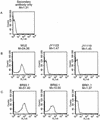Both family 1 and family 2 PspA proteins can inhibit complement deposition and confer virulence to a capsular serotype 3 strain of Streptococcus pneumoniae
- PMID: 12496151
- PMCID: PMC143380
- DOI: 10.1128/IAI.71.1.75-85.2003
Both family 1 and family 2 PspA proteins can inhibit complement deposition and confer virulence to a capsular serotype 3 strain of Streptococcus pneumoniae
Abstract
Pneumococcal surface protein A (PspA), a virulence factor of Streptococcus pneumoniae, is exceptionally diverse, being classified into two major families which are over 50% divergent by sequence analysis. A family 1 PspA from strain WU2 was previously shown to impede the clearance of pneumococci from mouse blood and to interfere with complement deposition on the bacterial surface. To determine whether a family 2 PspA can perform the same role as family 1 PspA, the family 1 PspA (from strain WU2) was replaced with a family 2 PspA (from strain TIGR4) by molecular genetic methods to make an isogenic pair of strains expressing different PspA proteins. Surface binding of lactoferrin and interference with C3 deposition by the two types of PspA proteins were determined by flow cytometry, and virulence was assessed in a mouse bacteremia model. Although the family 2 PspA appeared to bind less human lactoferrin than did the family 1 PspA, both PspA proteins could interfere with complement deposition on the pneumococcal surface and could provide full virulence in the mouse infection model. A mutant form of the family 2 PspA with a deletion within the choline-binding region was also produced. Pneumococci with this mutant PspA failed to bind human lactoferrin even though the PspA was present on the pneumococcal surface. The mutant PspA only partially interfered with complement deposition and moderately attenuated virulence. These results suggest that family 1 and family 2 PspA proteins play similar roles in virulence and that surface accessibility of PspA is important for their function.
Figures








References
-
- Abeyta, M. 1999. Ph.D. thesis. University of Alabama at Birmingham, Birmingham.
-
- Arnold, R. R., M. F. Cole, and J. R. McGhee. 1977. A bactericidal effect for human lactoferrin. Science 197:263-265. - PubMed
-
- Briles, D. E., S. K. Hollingshead, E. Swiatlo, A. Brooks-Walter, A. Szalai, A. Virolainen, L. S. McDaniel, K. A. Benton, P. White, K. Prellner, A. Hermansson, P. C. Aerts, H. Van Dijk, and M. J. Crain. 1997. PspA and PspC: their potential for use as pneumococcal vaccines. Microb. Drug Resist. 3:401-408. - PubMed
-
- Briles, D. E., J. Yother, and L. S. McDaniel. 1988. Role of pneumococcal surface protein A in the virulence of Streptococcus pneumoniae. Rev. Infect. Dis. 10(Suppl. 2):S372-S374. - PubMed
Publication types
MeSH terms
Substances
Grants and funding
LinkOut - more resources
Full Text Sources
Other Literature Sources
Molecular Biology Databases
Miscellaneous

